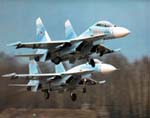The Rediff Special
According to Sareen, it was better
to buy a known devil
than an unknown one
 The history of major aircraft acquisition is instructive. The ASR for the deep penetration strike aircraft was made in 1972. The British Jaguar replaced a fleet of ageing Canberras and Hunters. After a long battle between the government and the air force, then prime minister Morarji Desai approved the purchase of five squadrons of Jaguars but Air Marshal Idrees Latif was content with four.
The history of major aircraft acquisition is instructive. The ASR for the deep penetration strike aircraft was made in 1972. The British Jaguar replaced a fleet of ageing Canberras and Hunters. After a long battle between the government and the air force, then prime minister Morarji Desai approved the purchase of five squadrons of Jaguars but Air Marshal Idrees Latif was content with four.
The Mirage 2000 arrived in 1985 in response to the new threat posed by Pakistani F-16s. In 1987, the MIG-29 was added to the combat fleet to bolster air defence. The present inventory of the IAF consists of a new British and French aircraft while the bulk of the fleet is of different class and type of Russian aircraft. The air force is sharply divided between being tied down to Russian equipment which makes up almost 80 per cent of all there is, and diversifying to Western aircraft. This feeling is shared by the army and navy too.
When Sareen took charge of the IAF in 1996, he had asked for more Mirage 2000 aircraft -- the advanced 2000-5 -- but was told there were no funds. According to Sareen, it was better to buy a known devil (Mirage) than an unknown one (Su-30) and also not add to the already large class of Russian aircraft. While there was no money for the Mirage, there was for Su-30 a fait accompli inherited from his predecessor and inveigled into the IAF by the government like the Bofors guns.
The two squadrons of Su-30s will be fully operational around the year 2007. By this time, production of the LCA should have begun, what chance then for the Su-30 also to be produced in India.
The biggest drawback of this extravagant multi-billion dollar deal is that the IAF has forfeited its flexibility. It will have no money for other priority items like upgrading serviceability of spares and consolidating existing assets. It can forget the AJT project, though the Russians are bending over backwards to sell their MiG-AT trainer nose prototype is under test evaluation in Russia. But, that is the subject of another story.
The problem with Soviet equipment is in training and spares. This is bound to get more acute given the division of and disarray in the former Soviet military industrial complex. The main plus point with Russian equipment was its raggedness and affordability due to convenient repayment and credit terms. All this has changed with the Russians now demanding hard currency.
The IAF have not only to reckon with the balance of power but also with the balance of payments accumulated in tens of billions with Russia. The IAF has not learnt any lessons from its experience with the MiG-29, a toothless wonder whose avionics and radar were non-operational most of the time.
Further, in two years, 30 engines were written off. In addition, it failed in its attempt to use the MiG-29 and Mirage 2000 to sanitise the air space. Reason: it has no ground control. The Su-30 has a Phased Array Radar but will have the same problem -- who will direct the aircraft.
Courtesy: Sunday magazine
Tell us what you think of this report
|





